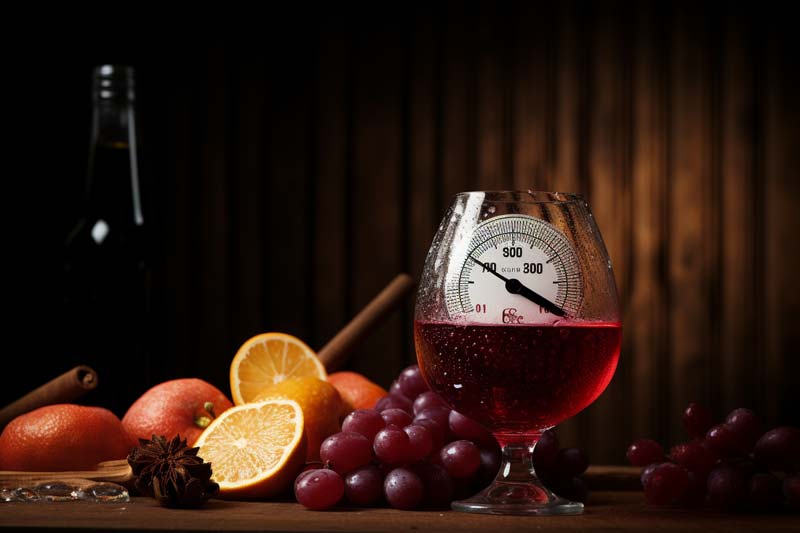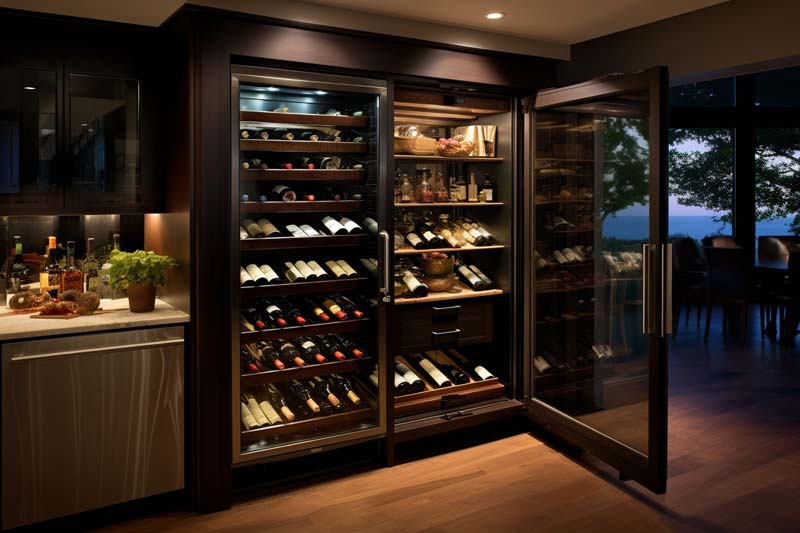Imagine this: you’ve spent years carefully curating a collection of exquisite wines, patiently waiting for the day when they will reach their peak and reward your dedication.
You’ve dreamed of that moment when you’ll finally open a bottle and experience the harmonious symphony of aromas and flavors that only comes with perfectly aged wine.
But here’s the thing, my fellow wine enthusiasts: aging wine requires more than just patience.
It requires the perfect environment – a wine fridge that understands the delicate dance between temperature, humidity, and storage conditions.
So, let’s uncover the secrets of the perfect wine fridge for aging wine, and consider exploring “Master Wine Storage: 8 Essential Guides on Wine Fridge Temperatures,” if you’re looking to become a true master.
With these seven secrets, you’ll be well-equipped to create a haven for your precious bottles and ensure they reach their full potential.
Table of Contents
The Science Behind the Perfect Aging Environment
Before we dive into the secrets, let’s take a moment to appreciate the science behind aging wine.
When you age wine, you’re allowing it to go through a transformative process.
Over time, complex chemical reactions occur within the bottle, resulting in the development of new flavors and aromas.
But these reactions don’t happen in just any environment.
Temperature, humidity, and light all play crucial roles in creating the ideal conditions for aging wine.
Secret #1: Temperature Stability is Key

If there’s one secret that every wine aficionado knows, it’s that temperature stability is essential for aging wine.
Wine is a delicate creature, easily influenced by temperature fluctuations.
The ideal temperature for aging wine is around 55°F (13°C).
At this temperature, the wine can gracefully mature and develop its full complexity.
But why is temperature stability so important?
Well, my friends, temperature fluctuations can wreak havoc on your aging process.
When the temperature rises and falls, the liquid inside the bottle expands and contracts, causing the cork to move ever so slightly.
This movement allows oxygen to seep into the bottle, accelerating the aging process and potentially spoiling the wine.
To ensure the stability of your aging environment, invest in a wine fridge that can maintain a consistent temperature over time.
Trust me, your bottles will thank you.
Why Fluctuations Can Ruin Your Aging Process
Let me tell you a cautionary tale, my friends.
Imagine you have a bottle of fine red wine aging peacefully in your wine fridge.
You open the door one day, only to find the temperature has skyrocketed due to a power outage.
Sure, it’s just a temporary blip, but that brief moment of heat exposure can have a lasting impact on your wine.
The increased temperature ages the wine more rapidly than desired, potentially resulting in premature oxidation and a loss of delicate flavors.
Remember, consistency is key. A stable temperature ensures a slow and gentle aging process, allowing the wine to evolve harmoniously over time.
Secret #2: Humidity Control Matters
Ah, humidity – the unsung hero of aging wine.
You might not think about it often, but maintaining the right humidity level is crucial for the well-being of your precious bottles.
The Delicate Balance Between Dryness and Dampness
Here’s the deal, my fellow oenophiles: wine bottles have corks for a reason.
These natural corks create a seal that allows a minimal amount of oxygen to interact with the wine as it matures.
But corks have an arch-nemesis: dryness.
If the humidity in your wine fridge drops below 50%, the corks can dry out, causing them to shrink and let unwanted air enter the bottle.
This, my friends, can lead to premature oxidation and spoilage. And trust me, you don’t want to experience the devastation of pouring a glass of “corked” wine.
On the other hand, excessive humidity can result in molds and label damage.
These pesky molds can taint the precious liquid inside the bottle and ruin your prized collection.
To strike the perfect balance, aim for a humidity level of about 70%.
This level ensures that the corks remain moist, maintaining their integrity and preventing any unwanted oxygen from sneaking in.
But how do you achieve this ideal humidity level? Fear not, my friends – a dedicated wine fridge holds the answer.
Picking the Right Storage Unit for Aging Wine
Now let’s dive into the secrets of picking the perfect storage unit for aging your precious wine collection. One may thing of a fridge or wine cellar, however, today we’re not discussing a wine fridge or cellar; wine fridge for the win!
Secret #3: Invest in a Dedicated Wine Fridge

Here’s the harsh truth, my friends: not all fridges are created equal.
A standard kitchen refrigerator might keep your food cool and fresh, but it’s not designed to provide the precise conditions necessary for aging wine.
To ensure your bottles age gracefully, invest in a dedicated compressor wine cooler specifically designed for storing and aging wine.
These magical fridges offer a unique set of features that cater to the needs of wine enthusiasts like you:
The Benefits of Separate Temperature Zones
Some wine fridges come equipped with separate temperature zones, allowing you to store different types of wine at their ideal temperatures.
For example, you can set one zone to a slightly cooler temperature for aging your red wines, while keeping another zone a touch warmer for your white wines.
This innovative feature ensures that each bottle gets the attention it deserves and allows you to create a tailored aging environment within a single fridge.
Secret #4: Size Does Matter
When choosing a wine fridge for aging wine, size does matter.
You’ll want to consider the size of your collection and how it’s likely to grow in the future.
After all, you don’t want to invest in a fridge that can’t accommodate your expanding treasure trove of aged wines.
Take stock of your current collection and estimate how many bottles you plan to add in the coming years.
This will help you determine the perfect size for your aging wine fridge.
Remember, my friends, aging wine is a journey, and you’ll want a fridge that can grow with you as you discover new vintages and delight in the art of maturing wine.
The Art of Organizing Your Precious Collection
Now that you have the perfect fridge, let’s discuss the art of organizing your aging wine collection.
Secret #5: Keep Bottles Horizontal for Longevity
It’s time to lay your bottles down, my friends.
When storing wine for long-term aging, it’s important to keep the bottles horizontal.
This position ensures that the cork remains in contact with the wine, preventing it from drying out and letting harmful oxygen seep into the bottle.
The horizontal position also allows any sediment to settle at the bottom of the bottle, keeping it separated from the liquid when it comes time to pour.
By embracing this simple organizational technique, you’ll ensure the longevity and quality of your aging wines.
Secret #6: Mind the Sunlight and UV Rays
Now, my fellow wine enthusiasts, let’s talk about a silent killer that can wreak havoc on your aging wine: sunlight and UV rays.
Exposure to direct sunlight or even ambient UV light can degrade the delicate flavors and aromas of your precious bottles.
These pesky rays can cause unwanted chemical reactions and lead to premature aging or off-flavors.
To protect your wine from this peril, store your aging collection away from direct light sources.
Choose a location in your home that is shielded from sunlight, or even better, invest in a wine fridge with UV-resistant glass.
This simple step will ensure that your aging wine receives the care it deserves and remains unspoiled by the harmful effects of light.
The Ritual of Opening Aged Wines: Unmasking the Treasure
Now that you’ve patiently aged your wines to perfection, it’s time to unmask the treasure.
Secret #7: Decanting and Patience for Optimal Drinking Pleasure
When it comes to opening aged wines, my friends, patience is key.
After years of aging, your wine has undergone a remarkable transformation.
But this transformation often leaves behind sediment, which can cloud the liquid and affect the drinking experience.
To enjoy your wine to its fullest potential, employ the art of decanting. Gently pour the wine into a decanter, leaving any sediment behind in the bottle.
But here’s the clincher, my friends: aged wines require time to open up.
This means that after decanting, allow the wine to breathe for a while before taking that first sip.
This step allows the flavors and aromas to fully emerge and gives you the ultimate drinking pleasure.
So, uncork that bottle of beautifully aged wine, embrace the ritual, and delight in the culmination of years of meticulous aging.
You deserve it.
As we reach the end of our journey through the secrets of the perfect wine fridge for aging wine, I hope you feel empowered to create the ultimate environment for your collection.
Remember, my dear oenophiles, aging wine is an art form – one that requires patience, attention to detail, and a perfect balance of temperature (don’t let it fluctuate!) and humidity.
Embrace these secrets, and let your aging wines mesmerize and delight you with each sip.